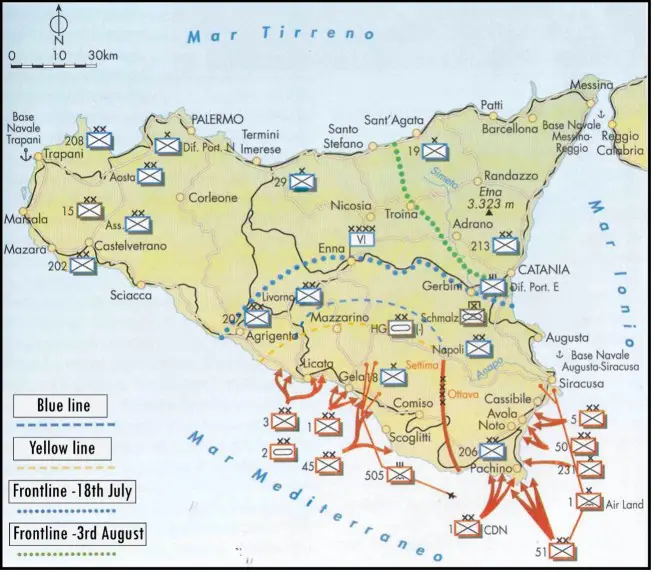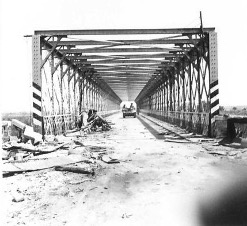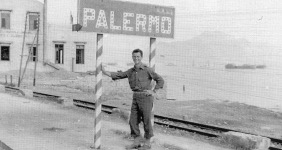After the first days of hard fight in Sicily, the allies advanced and then became stuck in front of Mount Etna. The fall of Mussolini and the battlefield attrition eventually forced the Axis to evacuate the island.
Battle for Sicily part 1 available here
After the failed axis counterattacks on the 11th of July, the Allied forces consolidated their positions and started to advance into the Sicilian countryside. In the sector of the British 8th Army (near Syracuse), the Napoli division fought a bloody rear-guard action to allow the withdrawal of German units towards Catania. In the skies, the situation was becoming dire for the Axis, in the first five days of the campaign, the Italian air force had lost 160 aircraft and the airfields were becoming more and more inoperable. However, the Regia Aeronautica continued to launch attacks against allied ships at Gela (11th July), using CANT Z 1007 and P.108 bombers.
On the 13th of July, the port city of Augusta surrendered, British advanced northwards and launched a bold airborne operation to capture the Primosole bridge, a vital choke point in the plain between Augusta and Catania.

Map of Operation Husky (A. Saccoman)
The battle of Primosole bridge
At sunset on the 13th of July, British paratroopers landed in the area, their launch suffered from many errors and inconveniences and the men were dispersed in a wide area, several kilometres away from the bridge. At 2:15 AM on the 14th of July, a handful of British paratroopers captured the bridge. A few hours later, the paratroopers were attacked from the north by the Italian X Arditi battalion but with no significant achievements. In the morning, the German Fallschirmjägers attacked from the south, initiating a bloody fight that lasted until the 16th of July, one of the few clashes between paratrooper units of the war.
On the 16th, the Germans decided to pull off, but the resistance at Primosole had severely delayed the advance of the 8th Army. General Montgomery decided then to initiate a manoeuvre on the left of the axis lines defending Catania.

The Primosole bridge
The fall of Palermo and the new phase
While Montgomery was struggling south of Catania, General Patton, commanding the American forces in western Sicily pushed on and captured Agrigento on the 17th of July. From this position, he received permission to launch a “reconnaissance” towards Palermo. American columns advanced northwards without encountering any significant resistance and capturing around 50.000 Italian of the weak and non-mobile coastal divisions. On the morning of the 22nd of July, American units entered Palermo welcomed by a jubilant crowd.

American Soldier in Palermo
By this point, the axis commands understood that the Allies could not be expelled from the island, so the strategy was to defend a shorter front and delay the enemy’s advance. Most of the Italian coastal units had been routed, captured or killed, the divisions Livorno and Napoli had lost most of their fighting strength in the counterattacks of the first days and their scattered companies and battalions continued to fight mixed with German units. The divisions Aosta and Assietta were on paper still fresh, but the continuous re-deployments and allied air attacks had caused many casualties and loss of equipment.
On General Hans Valentin Hube assumed command of the remaining axis forces, replacing General Alfredo Guzzoni. On the 25th of July. Mussolini had been sacked by the King and replaced with Marshall Badoglio. This political earthquake did not change anything in the field, but the Germans triggered their plans for securing the Italian peninsula in the prospect of Italy exiting the war (a scenario retained certain by the Germans). In this context, the defence of Sicily had to last as long as possible. However, evacuation plans were put in motion.
By the end of July, a new defensive line was organized on the hills and mountains in the north-eastern corner of Sicily. It stretched from Catania, passing in front of Mount Etna, the towns of Troina and Ardano and reached the northern coast (green line on the map). The first week of August saw again bloody fights all over the front, in particular in the area of Troina. The pressure on the axis units was unsustainable and starting from the 6th of August, General Hube started to pull off his forces. On the 7th, American units landed at Sant’Agata, behind the Axis lines, but failed to close the enemy into a trap. German divisions and the scattered Italian units fought a rear-guard action, moving towards Messina and starting the evacuation of Sicily.

Italian aircrafts destroyed at Catania
Axis evacuation and end of the campaign
On the 11th of August, the evacuation of axis forces began in Messina. The allied armies failed to engage the retreating enemy, delayed by the hard terrain, minefields and destroyed bridges. In the space of seven days, a flotilla of barges, warships and merchant ships transported to mainland Italy the following forces:
Germans: 39,569 men, 9,605 vehicles, 94 artillery pieces and 47 tanks
Italians: 70,000 men, 256 vehicles, 75 artillery pieces and 12 tanks
On the 17th of august, the allies were in full control of Sicily, the campaign was finally over after more than a month of bloody fights. The campaign saw high losses on both sides, summarised below.
Italians: 4,678 killed, 36,072 missing in action, 32,500 wounded and 116,861 captured
Germans: 4,325 killed, 4,583 missing in action, 13,500 wounded, 5,523 captured
British and Canadians: 2,938 killed, 9,212 wounded, 2,782 missing
United States: 2,811 killed, 6,471 wounded, 686 missing in action
Aircraft losses were particularly severe for the axis, the Italian Regia Aeronautica had 400 machines destroyed while the Luftwaffe had 740. The allies lost in total 375 aircraft.
The new Italian government soon started to negotiate with the allies an exit from the conflict, but the war will plague the Italian peninsula for almost two more years.
Sources
Alegi, G. (1994). Le operazioni in Tunisia e nell’Italia meridionale: l’aspetto aereo. L’ Italia in guerra: il quarto anno – 1943 (parte prima), 53-82.
Gay, G. (1994). La fine delle operazioni in Nord Africa, lo sbarco alleato in Sicilia e nell’Italia meridionale. L’ Italia in guerra: il quarto anno -1943 (parte prima), 25-32.
Giovanni Massimello, G. A. (2000). Italian aces of WW2. Osprey Aviation.
Jowett, P. (2019). L’esercito italiano nella seconda guerra mondiale. LEG edizioni.
Saccoman, A. (2007). La campagnia d’ Italia.
Sicurezza, R. (1994). Le operazioni in Tunisia e nell’Italia meridionale: l’aspetto navale. L’ Italia in guerra: il quarto anno – 1943 (parte prima), 33-52.